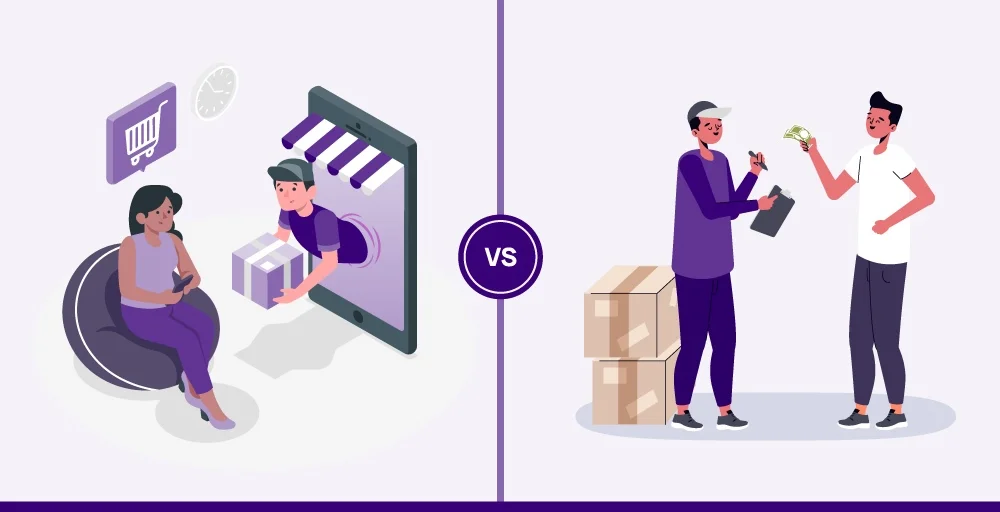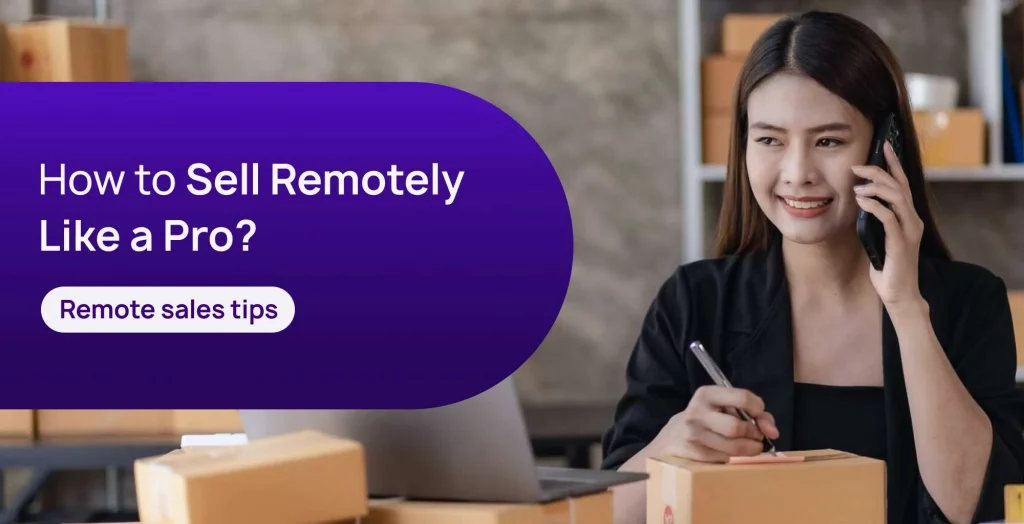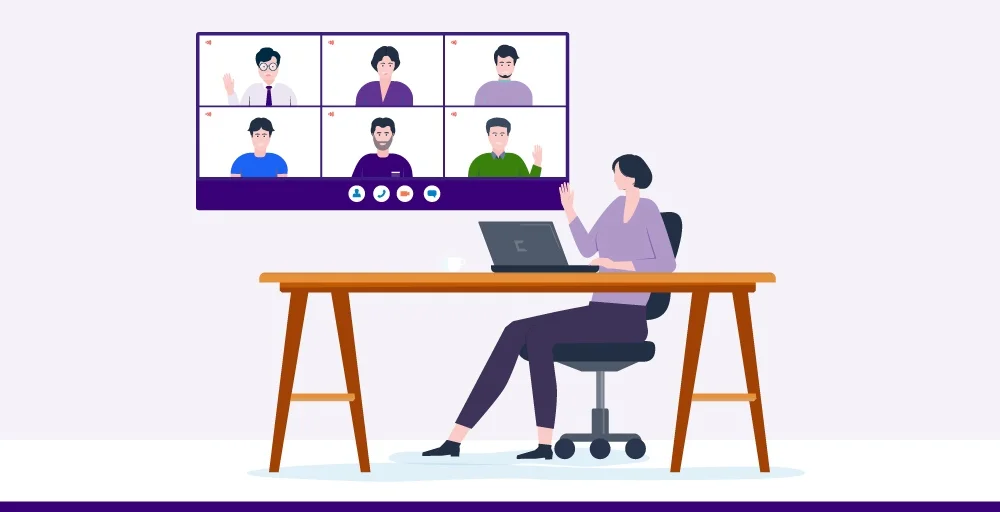In this digital era, remote selling has taken the world of sales to the next level. Salespeople can now sell their products virtually 😀, regardless of location.
Remote selling offers you multiple benefits, such as global connection, reduced cost, and increased productivity. So, more salespeople are switching from face-to-face selling to remote selling.
Further, one research also suggests that approximately three million people in the United States are selling their products remotely. But selling remotely in the beginning can be a very challenging task for you.
Don’t worry, this guide will help you to know what remote selling is, its benefits, and its challenges. Even more, we will equip you with the strategies needed to thrive in the world of remote selling.
🔑 KEY HIGHLIGHTS
- Remote selling is when the salesperson and the customer never meet in person during the entire sale process.
- Remote selling offers you several benefits, such as flexibility, wider customer reach, and reduced cost.
- The challenges you might face while selling remotely are lack of personal interactions with customers and conflicts in time zones.
What is remote selling?
Remote selling is when the salesperson and the customer never meet in person during the entire sale process. Instead of meeting face-to-face, they use virtual channels such as email and instant messaging to communicate with them and close the deals.

The remote market is thriving in the world of sales because of its several benefits. This includes lower costs, higher efficiency, global reach, and stronger collaboration with team members.
For instance, a person who sells software for a company that develops project management tools. She identifies a potential client, a marketing agency, through her online research. Instead of traveling to their office, she initiates contact via email, highlighting how her company’s software can streamline the agency’s project management and improve collaboration.
Remote selling Vs Face-to-face selling: What are the differences?
Remote selling and face-to-face selling have a huge difference. While face-to-face is a traditional method of selling where sales reps have to meet the customer in person, remote selling communicates with prospects via multiple channels and closes the deals.

Further, here’s a breakdown of the differences between remote selling and face-to-face selling.
| Remote Selling | Face-to-Face Selling |
| Salespersons and clients can be geographically dispersed. | Requires physical presence in the same location. |
| Typically made through digital channels (email, social media, etc.) | Often initiated through phone calls or networking events |
| Relies on effective communication skills and virtual tools | Easier to build rapport through in-person interactions and body language |
| Often utilizes online presentations, screen sharing, and video conferencing | Uses physical presentations, product demos, and in-person interactions |
| Leverages cloud-based document sharing, e-signatures, and proposal software | May utilize physical brochures, product samples, and contracts |
| Offers greater flexibility for both salesperson and client in scheduling meetings | Can be less flexible due to travel requirements |
| Reduces travel and office space expenses | Can incur travel and accommodation costs |
| Easier to track and analyze communication and engagement through digital tools | Limited data available on client interactions |
What are the benefits of remote selling?
Remote selling offers several benefits for your business. However, the main beneficial point of remote selling is its flexibility. Nonetheless, these advantages extend far from just being able to sell from anywhere. These are some key benefits of remote selling:
Remote selling reduces your costs
Travel, accommodation, and other costs can be expensive for you when going to face-to-face sales meetings and trade shows. But doing these things virtually helps you to save your time and money. The significant reduction of cost from travel, office space, and physical sales materials can be added to saving money for your business.
This saving amount can be invested in other resources such as marketing and product development. It will help you to reach more customers and improve your products as per customer needs.
Selling remotely enhances your productivity
There is a high chance that you can get stuck in traffic jams or endless trips to the airport while going to have a face-to-face meeting. This eventually delays your time and ends in canceling the meeting at the end of the hour.
But, remote sellers help you to enhance your productivity due to reduced commute times and fewer distractions. All of that time can be used to focus solely on increasing your sales.
Further, you can structure schedules for optimal focus and use tools to automate mundane tasks to streamline your workflows. It will free up valuable time for more strategic tasks.
You can reach wide customers
Remote selling has completely eliminated the geographical limitations of traditional sales territories. You can reach your potential customers all over the world by using phone, email, text messaging, and social media.
This will help you to enter into new markets, diversify your clients, and foster growth. Further, you can use CRM to organize the process that allows you to explosive growth in your business which is difficult for a field agent.
You have the flexibility to sell from anywhere
The main beneficial point of remote selling is that it gives you flexibility. No matter where you are, you can still sell your products to customers without any issue. This flexibility is a win-win situation for both you and your businesses, when you utilize it effectively.
Furthermore, remote selling leads you to increased productivity, improved work-life balance and eventually greater success.
What are the challenges of remote sales?
Where there is a wealth of benefits, there are greater challenges. 😔 You might also face several challenges while selling your product remotely. These are the main key obstacles to consider. 👇
Lack of personal interactions with customers
One of the main challenges for salespeople in remote selling is to build a close and harmonious relationship with potential customers. The absence of in-person interaction makes it difficult for leads to build trust in your brand.
Therefore, you must find other creative ways to establish a connection with them. For instance, you can send personalized emails, and video calls and engage on social media with them. This will help you to build rapport virtually and easily.
For that, you need a nuanced approach to ensure that trustworthiness and sincerity shine in each interaction.
Difficulty in providing product demonstrations
There are several ways that create challenges during product demonstrations such as technical issues, engagement and feedback, time and logistics, and demonstration skills.
However, one of the main common and frustrating issues is dealing with technical issues. This includes poor internet connection, video quality, and screen sharing problems. To overcome this problem, you need to invest in a reliable internet connection provider and additional tools and resources.
It helps you to ensure a clear and engaging product demonstration over video conferencing and screen sharing. Other than that, you need to have excellent demonstration skills to engage with customers while showcasing your products.
Conquering Technological Barriers
Technology can be both a blessing and a curse while selling your product remotely. It offers you the advantage of connecting with customers from all over the world as well as it also introduces technical challenges.
Remote selling relies heavily on technology, so an unreliable internet connection, software glitches, and security can disrupt sales processes and hinder communication. To overcome this problem, you need to have a robust IT infrastructure and backup plans.
This will help you to address potential technical issues and solve them as soon as possible.
Conflicts in time zone
Due to the different time zones, scheduling calls and meetings with clients across the globe can be tricky for you. This includes communication challenges, work schedules, and meeting scheduling.
But you can easily overcome the time zone barriers and create a positive and productive work environment. You just need to adapt and be willing to adjust team member’s or client’s schedules to accommodate their needs. In addition, you shouldn’t expect others to respond to your messages instantly.
Besides that, you can use the right tools to facilitate communication and collaboration and build trust and rapport among your team members.
How to sell remotely like a pro? 7 Proven Remote sales tips

The world of sales has transformed as now remote selling is ruling in the market. Remote selling has been growing constantly and more competitors are added ➕ in the market to sell their products.
So, you need a certain remote selling strategy to stay ahead of every competitor. Here are some key tips to sell your products like a pro. 👇
1. Be proficient in communication platforms
Proficiency in communication matters a lot when you are selling your products remotely. It is a key to building close relationships and closing deals virtually.
Other than that, you have to master all communication platforms. For example, mastering Zoom or Google Meet allows you to conduct engaging sales meetings, presentations, and demos.
Furthermore, it can bridge the physical distance and connect with clients on a deeper level, propelling your remote sales success.
2. Personalize your interactions with customers
It’s hard to understand a customer’s body language when you are connecting with customers through video conferencing. As a result, you need to find another way to read their body language.
This is where sales track software enters which allows you to read your customer’s digital body language. You can keep track of customer interest such as when they visit your website, what pages they look at, and time duration at these pages.
This valuable data will help you to understand their needs and allow you to personalize your interactions accordingly.
3. Craft a compelling sales pitch
It’s essential to focus on the customer’s desire and needs first while crafting a compelling sales pitch. This helps you to understand them more deeply. Then, you can pitch your products with a demo explaining how the products will fulfill their needs
In the demo, you can include statistics, case studies, and testimonials in your pitch to showcase the product’s effectiveness. These three elements not only add credibility but also persuade potential customers.
In addition, by adding these elements to your sales demo, remote sellers can engage their audience and drive conversions.
4. Take advantage of available technology
Technology plays a vital role in making your business successful and becoming a remote sales pro. You just have to leverage different available technology such as video conferencing platforms and CRM software.
With video conferencing platforms like Zoom, you can conduct engaging presentations and demos. And CRM software like HubSpot helps you to track interactions and manage your sales pipeline easily. These technologies bridge the physical gap and help to build strong relationships with clients.
5. Pay attention to time zone differences
Your clients or team members might be from different countries which eventually differentiate time zones. Therefore, you need to pay strong attention to time zones while scheduling meetings and calls.
You can also use scheduling tools that integrate time zones that allow clients to find a convenient meeting time. In addition, you can consider providing morning or evening slots to accommodate their location. This will help you to build strong relationships and close deals faster, regardless of location.
6. Create a strong presence on social media
Social media is the best way to advertise your products, explaining its benefits and features to customers.
As per one research, approximately 63% of the world’s population has been using social media. As a result, your products are most likely to reach more potential customers. This will eventually help you to increase leads and boost sales.
For that, you need to create a strong social media presence. To build a strong presence, you need to share valuable content showcasing your expertise and industry knowledge. In addition, you can engage with potential prospects by participating in relevant discussions in the comment section.
7. Stay competent and upgrade your skills regularly
If you are willing to sustain for the long-term in your remote selling business, it’s necessary to prioritize continuous learning.
You need to invest your time in product knowledge by attending manufacturer webinars or training programs. Remember that the deeper your product expertise, the more effectively you can showcase its value proposition.
Besides that, you must possess the most up-to-date knowledge of different tools and industry trends. This allows you to adapt and solve your problems creatively.
Remote selling best practices
Remote selling offers you several benefits, such as flexibility, wider customer reach, and reduced cost. This will certainly help you to increase your sales and grow your business. But you need to stay ahead of other competitors.
So, you need a strategic approach to master this virtual environment. These are some best practices of remote selling to thrive in this exciting new frontier. 👇
Use reliable and up-to-date CRM systems
One of the major remote-selling best practices is to use a reliable and up-to-date CRM system such as Salesforce and Hubspot. It helps you to stay organized and keep on top of deals.
Further, it stores all customer data including call recordings, past purchases, conversations, and more in a centralized platform. Apart from storing data, it also offers you several features such as analytics and productivity systems.
With these great tools, you can increase your leads and sales which eventually leads to success.
Track key sales metrics
Sales metrics are needed in businesses to measure the success of your sales. These sales metrics include:
- How many products sold
- Where was the buyer from
- What is the customer buying
- Customer language preference
- What issue are prospects trying to solve
Some of the sales metrics you can track are total revenue, sales cycle length, conversion rate, and churn rate. From these metrics, you can gather an insightful view of customers. These data can be used to analyze team members’ performance. In addition, you can also look out where new customers are coming from.
Plan your meetings effectively
You have to manage your calendar effectively to avoid back-to-back meetings with no breaks or double meetings at the same time.
It also helps to avoid a messy schedule and an inefficient sales process. Just give yourself some buffer time between meetings and only fix the time that is appropriate for you. This will help you to prepare for your meetings efficiently.
Overall, managing your calendar allows you to avoid a messy schedule and helps to prepare for your next meetings.
Build a strong outreach process
You need to create a strong outreach process to increase leads and build relationships in remote sales.
For that, you have to leverage multi-channel outreach. Don’t rely solely on emails, you can personalize outreach by combining calls, social media connections, and even video introductions. Then, tailor your message to specific customer news and challenges, explaining how your products or service can provide solutions.
Building a storm outreach process is important which helps you to attract qualified leads and build relationships.
Follow up
Keeping in touch with customers allows you to build strong relationships and gain information on whether your product solves their problems. But don’t send emails and messages that look pushy, desperate, and annoying to customers.
Find a good reason to email them and ask some questions such as “Does our product fulfill your needs” and more. This will help you to gain trust among customers and leave a mark to them that you really care about customers.
Request Feedback and Continuously Improve
Customer feedback is the most important thing that helps you to improve your product. So, don’t be afraid to ask customers for their feedback after each interaction. This includes surveys, calls, and even informal chats.
These feedbacks help you to recognize your product’s problem, which can translate into actionable improvements. It helps you to provide your products as per customer needs, leading to more prospect satisfaction.
How to manage a sales team remotely?
Managing your sales team remotely can be a challenging task for you. But don’t worry, here’s a breakdown of how to manage a remote sales team effectively. 👇

Set clear goals and expectations
Firstly, you have to set specific, achievable, and time-bound goals for your remote sales team. Then, clearly communicate with your sales team about the performance expectations. And ensure that every member is aligned on priorities and understands their role and team goals. This will provide a clear roadmap of goals and team success.
Conduct daily stand-up meetings and weekly review session
To maintain workflow, you can conduct daily stand-up meetings to discuss accomplishments, priorities for the day, and any issues that have occurred. This will significantly boost accountability, encourage collaboration, and build team spirit. Apart from daily stand-up, a weekly review session is required to analyze sales data, conversion rates, and lead generations.
Provide remote selling training and coaching
Sales teams need to have the right skills and knowledge to drive business to success. So, you need to provide remote selling training and coaching for your sales team to increase sales effectiveness and improve customer relationships.
Create a strong team culture
Team culture is vital for any successful team, but it takes extra effort. For this, you can schedule virtual team-building activities to encourage open communication. This supportive and collaborative environment among team members helps to increase their productivity which drives business to growth.
How to get into remote sales?
You can easily get into remote sales by following a few steps including
- Refine your skills: Firstly, you need to develop a strong skill set in sales fundamentals like prospecting, communication, negotiation, and closing techniques.
- Master the Tech Stack: Once you develop a strong foundation, familiarize yourself with the key communication and sales tools that are used in remote sales. This includes Zoom, Google Meet, and CRM software.
- Build your Online Presence: Then, create a compelling LinkedIn profile showcasing your sales skills, experience, and industry knowledge. If you have any prior experience working remotely, add this to your resume.
- Target Remote-First Companies: Just focus your job search on companies that specifically advertise remote sales positions.
- Network Strategically: Connect with remote salespeople and industry professionals at virtual networking events. This can offer you insights into the remote sales landscape and potentially lead to job opportunities.
- Practice Your Virtual Pitch: You need to develop a strong virtual sales pitch that resonates online and improve your video conferencing skills and practice giving presentations remotely.
- Prepare for Remote Interviews: Practice anticipating questions about working remotely and be comfortable with video conferencing platforms for virtual interviews. Focus on your ability to stay motivated, manage your time effectively, and excel in a virtual environment.
Power Up Your Remote Sales with KrispCall
You may struggle to be heard clearly during remote sales calls due to poor call quality. Or you might find it difficult to reach more customers worldwide.
These small problems clearly hinder your professionalism and cause a problem in closing deals. So, you need a reliable phone system that offers multiple features and crystal clear audio during calls.
KrispCall is the best VoIP service for home offering you crystal clear calls at an affordable price. It provides advanced calling features including real-time voice focus. You can leverage these features to build rapport and convert leads.
Furthermore, getting a virtual number from KrispCall allows you to enhance your remote sales strategy by establishing a local presence in any global market and enabling direct engagement with local customers
KrispCall takes care of the technical part of the phone system, leaving you to shine on every remote sales call.
Book a free KrispCall’s demo now and boost your remote sales. 🚀
Conclusion
Remote selling is in trend now in the world of sales market. It offers you multiple benefits such as reducing your cost, enhancing your productivity, wider customer reach and gives you the flexibility to sell from anywhere.
But in the selling process, you might face several challenges. This includes lack of personal interactions with customers and conflicts in time zones. But these problems can be overcome easily.
You just have to follow some simple tips, such as personalizing your interactions with customers, crafting compelling sales pitches, and taking advantage of available technology. These tips will easily help you to become a sales remote pro.
Apart from that, to thrive your business, you also need to handle your sales team efficiently. Overall, remote selling can be a challenging task for you but understanding and following some simple tips allows you to overcome those problems.
FAQ
Is remote sales hard?
Despite having several benefits such as flexibility and global connection, remote selling can be a challenge for you due to building trust and rapport with customers. However, you can overcome these problems by using different communication and CRM systems to personalize your conversations.
What does a remote sales person do?
A remote salesperson conducts all their business activities from remote locations. These are some of the responsibilities of a remote salesperson.
- Building Relationships
- Sales Presentations and Demos
- Negotiation and Closing Deals
- Prospecting and Lead Generation
How can I be successful in remote sales?
These are the key points to achieve success in remote sales:
- Master the art of virtual communication
- Be proficient in the communication and sales tools
- Set clear work hours and create a dedicated workspace to minimize distractions
- Focus on listening, understanding customer needs
- Stay up-to-date in the industry trends and new tools
- Set specific, measurable, achievable and time-bound goals





